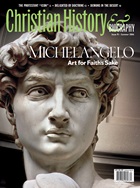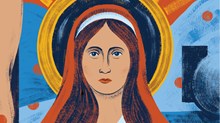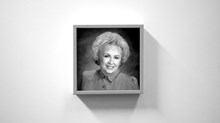The man acclaimed as "the father of monasticism" never dreamed of the huge impact he would have. But the new mode of discipleship he helped bring to birth in Egypt in the early 300s A.D. turned out to be one of the most momentous innovations in the church's first thousand years.
The book that started it all
Alexandrian bishop Athanasius (298-373) was exiled five times from his beloved church at the hands of Arian-sympathizing emperors. In one of these exiles, the staunchly orthodox, diminutive firebrand fulfilled a long-time dream by traveling to the desert to share the life of the hermits there. During what became a lengthy ascetic sojourn, he wrote what historian Derwas Chitty correctly calls "the first great manifesto of the monastic ideal." This was not some tidy, orderly rule of life, but rather a biography of the most gripping sort—of the best-known early monk and first "desert father," Antony of Egypt (251-356).
Antony was the son of a prosperous Egyptian peasant-farmer. Shortly after his father died, he heard at a church service the gospel words "Sell all you have, give to the poor, and come, follow me." In response, he sold his birthright—200 acres of lush, fertile Nile valley land—and began to live as a solitary at the edge of his small town.
This sort of hermit lifestyle was already a known practice in Egypt by Antony's youth, and it fascinated the young man. He apprenticed himself to a local holy man, absorbing from his elder everything he could learn about the ascetic life. Askesis meant "training"—especially the body-building the Greeks had always been so keen to practice in their "gymnasiums." It never entailed merely giving up things, like food or sexual relationships. Rather, it was a mode of exercising and training the heart.
The flight to the desert
Seeking further separation from the distractions of town life, the intense young man went out into the desert. This was real desert, not for the faint of heart: the scorching expanse of sand that covered the vast majority of Egypt outside the thin strip made green by the Nile's seasonal flooding. It was said that nothing could live in those parts except demons. This suited Antony. Like many Eastern Christians who followed him, he had a keen sense of the spiritual battle that surrounds all of us.
First the young man sealed himself in a tomb not far into the desert, depending on some villagers to bring him food. Then he moved farther out to a ruined Roman fortress on a mountain by the Nile, which became his home for 20 years. There he indeed encountered demons, in the form of wild beasts, sent by the devil to intimidate him. But Antony mocked them, reminding them that Christ had robbed them of any authority and cast them down. And not being able to withstand his scornful ridicule, they disappeared.
In 305, the second year of the last great persecution of the church, Antony emerged from his ruined fort with the help of some villagers who broke down the fort's door. After 20 years shut away in solitude, he stood before them cheerful and in glowing health, in full possession of his senses, having attained the Greek ideal of apatheia or emotional equilibrium.
Learning of the persecution, Antony returned to the city and sat in court in silent solidarity with his Christian brothers and sisters soon to be martyred. Antony himself sought martyrdom, but it was not to be. Once he returned to the desert, a stream of people increasingly sought him out—some, perhaps, to escape the threat of death to Christians in the cities, others to prepare themselves for martyrdom, and still others simply coming to see what all the fuss was about. This was the time when, as Athanasius said, "the desert became a city," and Antony's fame spread far and wide as he dispensed healing miracles and words of wisdom to the gathering crowd of imitators and devotees.
Finally, in his sixties, Antony again grew restless for solitude and sought a deeper, more private corner of the desert in which to pursue God. Moved by the Spirit, he went with a caravan of Arabs several days' journey into the desert toward the Red Sea, to an isolated oasis at a mountain's foot. However, Antony's last attempt at solitude failed. Even at this remote retreat in the Eastern Desert, he found himself needing to maintain an herb garden to feed the many seekers who trekked through the desert to receive spiritual food from his lips. There, at his "inner mountain," where today stands the monastery of Saint Anthony the Great, Antony lived out the rest of his 105 years.
Monasticism's beloved father
Apart from being compellingly written and describing a larger-than-life subject, Athanasius's biography of Antony commanded attention by its discerning description of the monastic life's twin energy. This double dynamic, learned from the apostles and early martyrs, consisted on the one hand of athletic, near-heroic self-exertion and self-interrogation, and on the other of God's gracious help from heaven through Christ—a duality that would shape all future monastic movements.
Within a few decades after Athanasius completed the Life of Saint Antony in 357, not only the Greek-speaking Christians of the eastern Mediterranean but also the Latins in Italy and Gaul knew of Antony. By 400, he was already a figure of legendary proportions—perhaps the first real "Christian celebrity."
As the Middle Ages dawned, only a dwindling few chose to imitate Antony's solitary form of spiritual life, while most flocked to the cenobitic (communal) form. Antony remained, however, the beloved father of all monks. Throughout the medieval period, each monastic revival looked back in filial devotion and held itself up to the glass of Antony's ancient Egyptian movement. In this way, the life story of Antony has become for his heirs, says the late Dom Jean Leclercq, "a living text, a means of formation of a monastic life."
Indeed, the open secret of monasticism is that it has always spread by imitation rather than theoretical instruction. Monasticism is ultimately a thing you do rather than think about or learn. Thus it is fitting that a biography, rather than a rule, is really the founding document of the movement. Says the modern English translator of the Life, Robert Gregg, "The testings and miracles of Antony fixed themselves in the consciousness of the Church and of Western culture as a sharp image of what a life committed to God demands and promises."
In a symbolic act at the end of Antony's life, he had one of his two sheepskin cloaks given to his friend Bishop Athanasius. In response, Athanasius felt that the greatest and most important tribute he could pay his treasured friend and model Antony would be to spread the contagion of his special style of discipleship by making the monk's story known in a short biography. Thereby, thousands who had never met this spiritual warrior of the wastelands would fall under his magnetic influence.
Never have a writer's aspirations been so powerfully fulfilled.
Chris Armstrong is associate professor of church history at Bethel Seminary and a senior editor of Christian History & Biography.
Copyright © 2006 by the author or Christianity Today/Christian History & Biography magazine.
Click here for reprint information on Christian History & Biography.

Support Our Work
Subscribe to CT for less than $4.25/month





























